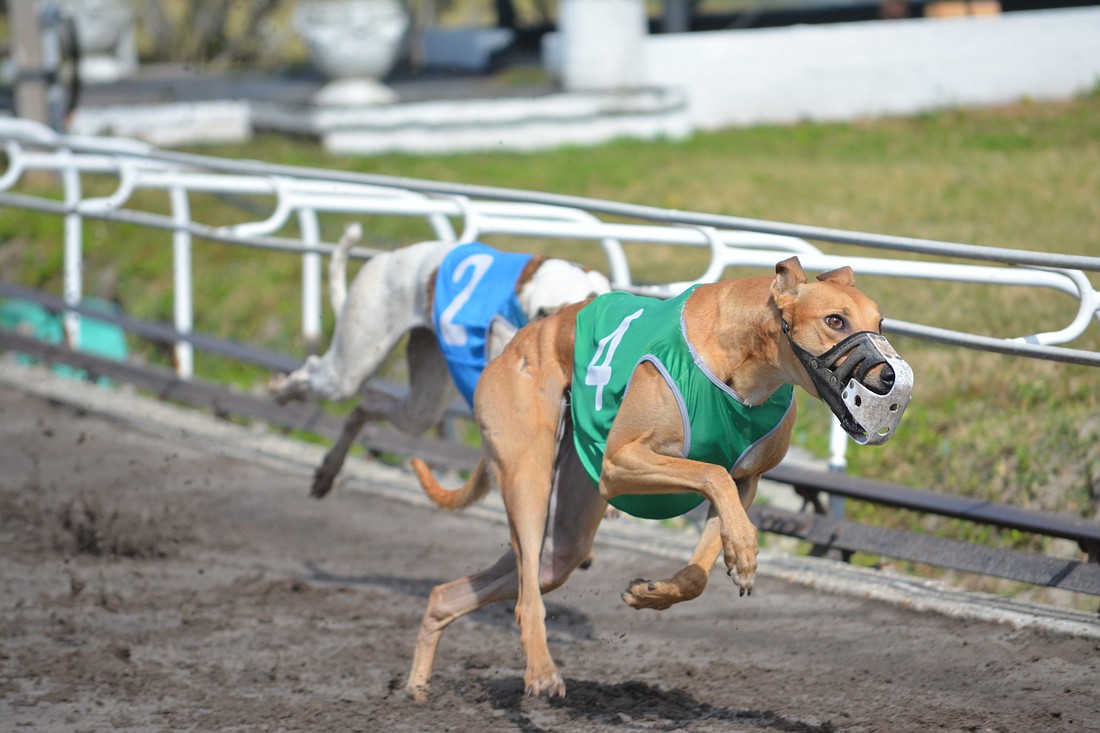- May 3, 2025
-
-
Loading

Loading

I stood beside a handful of middle-age smokers. Some of them sipped beers from plastic cups, others sat and flipped through the program. It was 12:24 p.m. We were all watching, waiting, for the show to begin. No one sat above us in the stands. I leaned against a low fence, the only thing between me and the track that would shortly be torn to shreds by pounding paws. Nancy Guimond, the paddock judge, had told me of the perfect spot.
I had never before been to a race like this.
At 12:25 p.m., eight greyhounds made their way onto the Sarasota Kennel Club track with their lead-outs, something akin to a pre-race handler, in tow. A recording of “First Call” rang through the track’s PA system, the audible symbol of a race about to begin. The lead-outs walked the hounds to the starting box. Soon, barks emerged from the box. Not barks of pain, or confusion, but of excitement.
The mechanical lure whirred to life, and made its way around the bend. Once it reached the sight lines of all the dogs, the boxes were opened, and the hounds were off.
If you’ve never seen a greyhound run, and I mean really run, consider yourself an unlucky soul. They run with a rocking motion almost too quick to be seen without blur. Head down, front and back legs extended, then the head comes up as the front paws hit the dirt and push off. It seems like they spend more time in the air than they do on the ground during a race.
In other words, they can fly. The greyhounds can run a 5/16 of a mile race in 31 seconds, give or take.
Watching them race, it becomes obvious that running is what these dogs were born to do. Once they cross the finish line, the dogs get doted on by their trainers and the track workers.
They looked so happy.
If only more people were there to see it.
Thomas Bowersox is the director of racing at the track. He gave me a few reasons for the declining interest in his sport. Online gambling has made it easier for people to spend money without leaving their couch. The Florida Lottery has managed to draw people in, as well, he said. Is it really more fun to scratch a ticket with a quarter than to watch a greyhound show off its athleticism? To each their own, but I would disagree.
The big hangup though, Bowersox told me, is the misconception of how the hounds are treated. Shocked while in the starting box. Pumped with performance-enhancing drugs. You name the mistreatment, it has probably been alleged of greyhound racing at some point.
I saw no evidence of anything resembling mistreatment on my visit. Bowersox has been in the racing business for 55 years. He started out as a lead-in himself. He is, and always has been, an animal lover. He just added a 4-month-old Golden Retriever named Bentley to his home.
There is no animal cruelty in his heart, or at the Sarasota Kennel Club. In fact, Bowersox said, the greyhounds probably get treated better than the average house dog. They are cared for all day, every day. No one leaves them by themselves to go to work, because they are the work, and beloved work at that. Dogs are tested for drugs before each race. They are petted, played with and scratched.
Guimond got into the business 32 years ago because she fell in love with the dogs and the way they run. It is poetry in motion in the purest form. She previously worked at a track in Arizona that was shut down due to ongoing protests. Her everlasting memory of that place will be a 19-year-old assistant sobbing around back of the track, saying goodbye to the dogs he loved.
“Greyhound people are nuts,” Guimond said. “Every last one of us.”
Maybe you’re still skeptical. That’s OK. I was too.
Then I saw them sprint, their eyes alight with fire and determination. A few times, the dogs’ protective muzzles came off during a race to reveal ear-to-ear smiles and tongues flapping through the wind.
I knew, then, that beyond all the betting, beyond the cheap beer and discarded packs of Pall Malls, was a sport that gave greyhounds purpose, and that’s a pretty great thing.